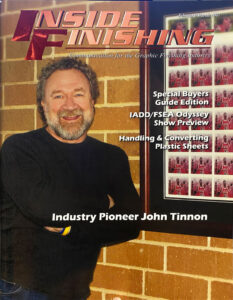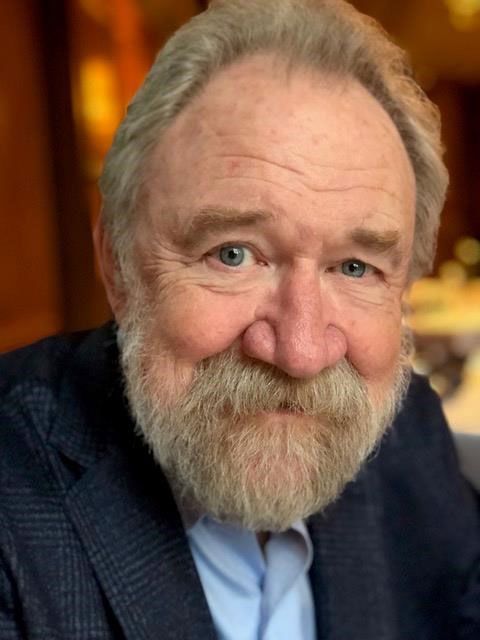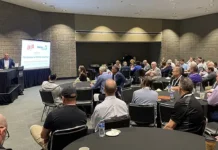By Kym Conis, former assistant director, FSEA
John R. Tinnon of Glencoe, Illinois, was born on September 1, 1948, in Caruthersville, Missouri, and left this earth on June 25, 2020, after a long illness. Tinnon was a charismatic, generous and commanding man of integrity with a sounding laughter and a smile for everyone. He cared passionately about his family and his friendships and was a mentor to many. He spent more than 40 years as a founder, owner and chairman of a number of companies relating to the graphic arts industry. His pioneering spirit, leadership and contagious energy permeated the entire industry from the implementation of business models to his guidance in the Foil and Specialty Effects Association (FSEA). Building and restoration were recurring themes in his career. Tinnon was awarded an FSEA Lifetime Achievement Award in 2007. The following article appeared in the February/March issue of Inside Finishing.
Perfecting a craft can be a powerful first step toward success. Applying the right business strategies to mold that craft into a thriving finishing operation is more powerful yet. Combine the two with an indomitable spirit unafraid to set the industry bar – time and time again – and you have a force destined to shine. Over a thirty-year span, John Tinnon led a remarkable team in building one of the largest turnkey graphic arts finishing operations in North America, Graphic Converting, Inc. Through his dynamic leadership style, coupled with his forward-thinking attitude and wherewithal to make things happen, John Tinnon provided inspiration and guidance into territories unknown.
This pioneering spirit and contagious energy permeated the entire industry, from the implementation of bold business models to the initial formation and guidance of the formerly named Foil Stamping and Embossing Association (FSEA). In tribute to these accomplishments, as well as to his dedication and significant contribution to the foil stamping and embossing industry at large, the FSEA is proud to honor John Tinnon with the 2007 Lifetime Achievement Award. As a successful trade entrepreneur and one of the founding fathers of the FSEA, Tinnon is recognized for his steadfast commitment to sharing knowledge, breaking down barriers and implementing change amidst an industry in need of direction – forever redefining the role of today’s ‘trade finisher.’
The inception of Graphic Converting can be traced back, in part, to Tinnon’s childhood – to the influence of his father’s background in diemaking and diecutting. “I was rubbering dies when I was just ten years old on weekends in the basement of our house,” recalled Tinnon. Working summers at a large finishing operation in Chicago, and part-time during high school and college, Tinnon started full-time upon graduation and worked in various capacities over the next five years, including estimating and eventually, general manager. After a few years (and a few points of disagreement), Tinnon set out on his own to seek new opportunities.
“It has a lot to do with luck with a capital L.” – John Tinnon

Getting a ‘lucky’ break, a good friend in the printing business, Marv Lee, lent Tinnon $10K to start his own business, with the understanding that Tinnon would buy full control when he was able. Allotted 3,000 sq. ft of space in Lee’s facility, Graphic Converting .was established in late 1976 with a Thomson diecutter, a hand mounter, some small miscellaneous finishing equipment and four employees.
In its first year of business, Graphic Converting, Inc. (GCI) did just over a quarter of a million in sales and succeeded in nearly doubling that amount every year for the next five. In 1978, Tinnon was joined in partnership by Nia Chrisos (who also worked for Lee and who did the bookkeeping for GCI) and Tom Burnight – both bought into the company for a small percentage. When Lee unexpectedly passed away a short time later, the division of ownership was 2/3 Tinnon (president) and 1/6 for both Chrisos (VP of operations) and Burnight (VP of sales), which remained the structure until 1986. “I later found out from executors of Marv’s estate that when he lent me the money, he had really intended to groom me to run one of his businesses,” Tinnon explains. “He never expected Graphic Converting to take off – they got a very good return on their investment!”
After just two short years in business, GCI ran out of space and in late 1979, rented 35,000 sq. ft. in a 120,000 sq. ft. facility on West Division in Chicago, which provided the room for GCI’s first Bobst diecutter. One year later, in addition to several other machine purchases, GCI made a pivotal move to enter the foil stamping arena with a Bobst BMA. “We jumped right in and went straight for large format stamping,” recalled Tinnon. In 1984, GCI once again ran out of room and purchased the entire facility it had been renting.
“We grew so quickly over the course of five years that we started to experience some major growth pains.” – John Tinnon
Over the next decade and a half, GCI would take on a new shape, in part through a series of acquisitions fueled by an educational journey on which Tinnon would soon embark. “We were growing very quickly and the company was experiencing some major growth pains,” explained Tinnon. “I really didn’t know much about business,” and so in quintessential Tinnon style, he did something about it and went back to school. Entering Harvard University’s OPM Program (Owner/President Management Program) in 1985 was just the boost the company needed to manage its growth.
The company’s first acquisition in 1985 was Classic Finishing, a company that had shared rental space with GCI before the purchase of the building. Gillespie followed in ’86, Lidtke Binding in ’88 and the manufacturing operation of Upper Deck in 1997. It was as that time that Steve Skalski joined the GCI team as a partner and remains today an integral force behind the company’s overwhelming success in the trading and game card industry. Three more acquisitions were made at the start of the new century, including Midwest Graphic Finishers and DynoPress, both of which were later closed down, and the trading and game card division of Great Western Industries in Dallas, Texas – its final acquisition to date.
But to a greater extent, GCI’s talent in the finishing arena would be molded by a complete paradigm shift and refocus on the way it did business. Prior to the Upper Deck acquisition, Graphic Converting moved into its final location as a trade finisher – a 150,000 sq. ft. facility in Niles, Illinois. Now armed with the space, equipment, dedicated partners (Burnight and Skalski) and most importantly, loyal, hard-working employees necessary to implement its goals, Graphic Converting took flight.
“Success is attributed to the basic concept of doing business – establishing solid, long-term relationships with your customers and vendors; hiring good people and keeping them happy; and surrounding yourself with bright people.” – John Tinnon
Recognized for providing the highest quality products and services, GCI became one of the largest trade finishers in the industry with more than 300 employees located nationwide at over 400,000 sq. ft. of space combined in its Niles, Illinois, Carlsbad, California, and Dallas, Texas facilities. From structural design and project engineering to digital printing, UV coating, film laminating, foil stamping/embossing, mounting, diecutting, collating, folding/gluing, assembly, fulfillment, and just-in-time shipping, Graphic Converting had the capability to create powerful, image-enhancing solutions unique to each particular application.
Always leading by example, Tinnon encouraged and inspired his employees to exceed even their own expectations. His leadership style created an entrepreneurial atmosphere that was fun, energizing, and creative – one where everything and anything was possible when it came to taking care of a customer. Tinnon continually stressed the importance of integrity, whether interacting with a customer, partner, employee, supplier or competitor: “Be completely and totally ethical; it is the one constant that will endure through good and bad times.”
“You always have to be looking at your strengths and ask: What are our core competencies and how do they apply to other industries?” – John Tinnon
Concepts such as project management, turnkey operations, direct marketing and market expansion became key core competencies as Graphic Converting worked to establish a new relationship with its customers and a new role as a trade finisher in an industry where the business climate was dramatically changing. Tinnon realized early on that the ‘traditional’ role of the trade finisher, that which was defined by the printer’s ability to ‘close the deal’, would need to be redirected. And thus, the company began to employ the direct approach by targeting its customers with customized presentations that provided solutions to their needs. To this end, GCI began to create elaborate direct marketing pieces that the company could use to focus on particular market segments. Eye-catching sales pieces such as a self-promotional package entitled “Release Your Imagination,” which was created specifically to target designers, not only set out to bedazzle the viewer and sell the company’s services but also, often served as an educational tool to increase awareness and thereby, grow the industry at large.
GCI also began to target other market segments in addition to trade finishing in the early 1980s. Starting with the greeting card arena, GCI took this market one step further by establishing dominance in outsourcing manufacturing by providing capabilities that included print through specialized card packaging. In the late 1980s, GCI targeted the trading card market. Under Tinnon’s direction, GCI drove the consolidation of trading card manufacturing by offering a single source where all trading card and collectible game card marketing companies could have their products produced. By creating one facility that manufactured cards only, GCI was able to create a highly efficient operation that would benefit the trading card industry as a whole. With the acquisition of the Dallas, Texas, facility, this market segment eventually would become (as of 2005) GCI’s main and only core competency.
At this same time in the late 1980s, GCI began to target packaging and point-of-purchase (POP) displays, developing a niche in the small format and specialty POP market. Time and again, the structural design created by GCI’s team of award-winning designers was the reason the company was given the job. From there, quick-turnarounds and a ‘can-do’ approach continued to bring in unique display projects that included sound, lights, motion and multiple levels of dimension.
This market was one area that GCI targeted as a tradeshow exhibitor – another bold move for a trade finisher at the time. 1996 was the first year that GCI participated in tradeshows and it did so with style. A new custom-designed display was utilized at its first POP Show in Chicago. As was (and still is) with most subjects, visual stimulation was critical and tradeshows were no exception. GCI continued to support the POP, greeting card, publishing, and premiums and printing industries at trade shows.
The trade finishing portion of GCI, located in the Niles facility, eventually reached a point where it no longer could compete profitably in an industry where finishing work had become better suited towards smaller operations – ‘small’ as compared to Graphic Converting. “Our next move was either to add printing capabilities and become a complete turnkey operation, or to sell that end of the business and concentrate on what would be the most profitable,” explained Tinnon.
Thus in 2005, the ‘finishing giant’ sold that segment of its business to JohnsByrne Company. Today, in the process of yet another move that is expected to be completed by the end of 2007, GCI’s California facilities are closing down and moving to its newly expanded and renovated Dallas facility – orchestrated by partners Steve Skalski, CEO in charge of operations, and Joe Yaney, CFO in charge of finances. Tinnon and Burnight are semi-retired, remaining in the picture but not on the day-to-day scene. GC Dies, a spin-off division of Graphic Converting located in Elmhurst, Illinois and run by President Mick Tinnon, remains in operation today, supplying steel rule dies nationwide.
Tinnon’s pioneering spirit was never more apparent than with his guidance and leadership of the Foil Stamping and Embossing Association during its formative years. Serving on the FSEA Board of Directors from its inception in 1992 and for nearly ten years to follow, Tinnon worked with a dedicated team to achieve a number of goals: to unite its members and the industry through education and standardization; to create true value for association members; and to heighten industry awareness and thereby, increase growth. During Tinnon’s tenure on the board, serving as Chairman for three years, Tinnon worked on a number of projects – several of which remain a part of FSEA operations today. “It was a great group of people to work with,” recalled Tinnon. “There were no egos – no issues; we all worked towards a greater goal.”
Among the many projects that came to light under Tinnon’s leadership on the board was the Fall Seminar Series, which the FSEA launched in three major cities throughout the US in 1994. “I remember giving a presentation entitled BAIL (Banker, Accountant, Insurance Agent and Lawyer), which set out the importance of establishing a core group of specialized professionals to help run your business successfully,” explained Tinnon. The popular seminar series was just the beginning, as the association also launched its inaugural national convention in Chicago in 1995. Projects such as the Pantone Foil Selector Guide and the massive undertaking of A Different Breed: The Designer’s Guide to Foil Stamping and Embossing, which was produced live at Print ‘97 in Chicago, were just a few of the springboards from which the FSEA promoted industry awareness and standardization nationwide. Both were projects in which GCI played a large part from start to finish.
Other FSEA projects that came to light during that time were the Gold Leaf Awards Competition, a formal membership directory, a unified glossary of industry terms and the association publication InsideFinishing. Even after Tinnon stepped down from the board, his involvement and support never ceased, lending assistance with association projects and committees whenever possible.
Outside the industry, Tinnon’s entrepreneurial spirit has taken new directions. Currently, he is a partner in a company called IDM (In-Development and Management Company), which specializes in the hospitality market. Collectively, Tinnon, along with a set of new partners, owns and/or manages several properties throughout Wisconsin, including the Jefferson Street Inn and City Grill in Wausau, The Beloit Inn in Beloit, and his newest venture The Gordon Lodge, a 135-acre shoreline resort with “the most beautiful sunsets in Door County!”
Awarded Entrepreneur of the Year (Chicago) by the University of Illinois and Chicago Small Business of the Year before that, Tinnon’s long list of accomplishments has not gone unnoticed – even outside of the industry. A man of great integrity, charisma, dynamic leadership ability and an uncanny eye for business, John Tinnon remains as energetic and forward-thinking as he was over three decades ago, running a hand-fed diecutter at night and selling jobs by day. An inspiration to all who know him, and to many who’ve only heard the tales, John Tinnon remains a pioneer into territories unknown.




